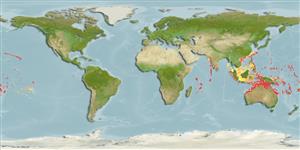Issue
The species Acanthurus nigros Günther 1861 is considered valid in Eschmeyer (CofF ver. Sep. 2011: Ref. 88002) following Randall & Parenti (2011). But could be an unjustified ementation of nigroris. More studies are needed.
Environment: milieu / climate zone / depth range / distribution range
Ökologie
seewasser riff-verbunden; tiefenbereich 1 - 90 m (Ref. 1602). Tropical; 30°N - 26°S, 52°E - 137°W
Indo-Pacific: Aldabra and Seychelles to the Hawaiian, Marquesas and Tuamoto Islands; throughout Micronesia.
Size / Gewicht / Alter
Maturity: Lm ? range ? - ? cm
Max length : 25.0 cm TL Männchen/unbestimmt; (Ref. 2334)
Rückenflossenstacheln (insgesamt) : 9; Rückenflossenweichstrahlen (insgesamt) : 24 - 27; Afterflossenstacheln: 3; Afterflossenweichstrahlen: 23 - 25. Color drab dark brown; spots on body located at the rear base of dorsal and anal fins. Black spot at rear base of dorsal fin not large, its greatest width more than 2 times in eye diameter. White posterior margin of caudal fin very narrow, its width less than 4 times in pupil diameter. No definite black margin around groove of peduncular spine. Body depth 1.8 to 2 times in SL. Maximum standard length about 20 cm (Ref 9808).
Inhabits clear lagoon and seaward reefs; often in areas with mixed coral, pavement, rubble and sand substrates (Ref. 1602). Benthopelagic (Ref. 58302). Occurs singly or in small groups (Ref. 9710). Feeds on filamentous algae, diatoms and fine algal film of compacted sand (Ref. 1602). Relatively uncommon throughout Micronesia; rare on Great Barrier Reef.
Life cycle and mating behavior
Maturities | Fortpflanzung | Spawnings | Egg(s) | Fecundities | Larven
Randall, J.E., 1956. A revision of the surgeonfish genus Acanthurus. Pac. Sci. 10(2):159-235. (Ref. 1920)
IUCN Rote Liste Status (Ref. 130435)
Bedrohung für Menschen
Harmless
Nutzung durch Menschen
Fischereien: kommerziell; Aquarium: Kommerziell
Tools
Zusatzinformationen
Download XML
Internet Quellen
Estimates based on models
Preferred temperature (Ref.
123201): 24.8 - 28.8, mean 27.4 °C (based on 286 cells).
Phylogenetic diversity index (Ref.
82804): PD
50 = 0.5000 [Uniqueness, from 0.5 = low to 2.0 = high].
Bayesian length-weight: a=0.02344 (0.01103 - 0.04981), b=2.96 (2.79 - 3.13), in cm total length, based on LWR estimates for this Genus-body shape (Ref.
93245).
Trophic level (Ref.
69278): 2.0 ±0.00 se; based on food items.
Widerstandsfähigkeit (Ref.
120179): hoch, Verdopplung der Population dauert weniger als 15 Monate. (Preliminary K or Fecundity.).
Fishing Vulnerability (Ref.
59153): Low vulnerability (15 of 100).
Nutrients (Ref.
124155): Calcium = 67.7 [27.5, 195.0] mg/100g; Iron = 0.8 [0.3, 2.0] mg/100g; Protein = 18.1 [16.8, 19.3] %; Omega3 = 0.116 [0.054, 0.241] g/100g; Selenium = 20.6 [7.2, 63.2] μg/100g; VitaminA = 43.3 [9.9, 178.5] μg/100g; Zinc = 2.95 [0.94, 5.46] mg/100g (wet weight);
